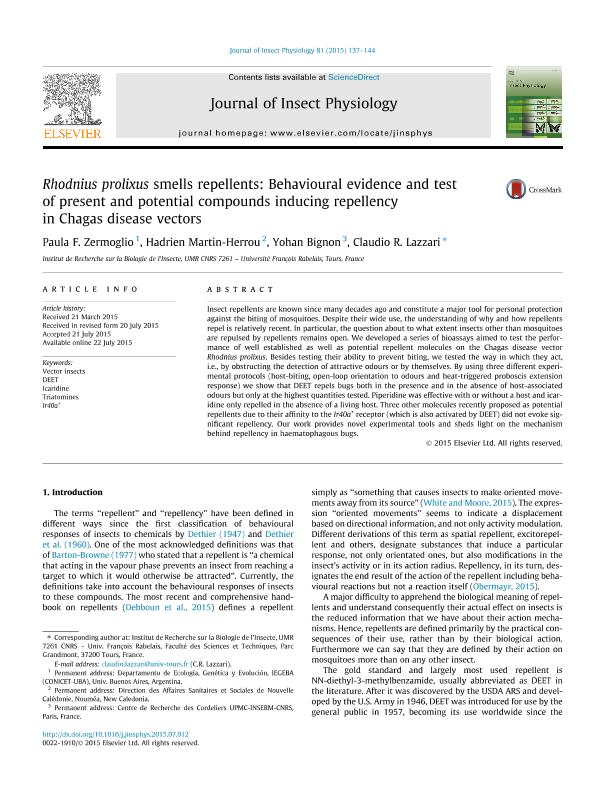Artículo
Rhodnius prolixus smells repellents: Behavioural evidence and test of present and potential compounds inducing repellency in Chagas disease vectors
Fecha de publicación:
10/2015
Editorial:
Pergamon-Elsevier Science Ltd
Revista:
Journal of Insect Physiology
ISSN:
0022-1910
Idioma:
Inglés
Tipo de recurso:
Artículo publicado
Clasificación temática:
Resumen
Insect repellents are known since many decades ago and constitute a major tool for personal protection against the biting of mosquitoes. Despite their wide use, the understanding of why and how repellents repel is relatively recent. In particular, the question about to what extent insects other than mosquitoes are repulsed by repellents remains open. We developed a series of bioassays aimed to test the performance of well established as well as potential repellent molecules on the Chagas disease vector Rhodnius prolixus. Besides testing their ability to prevent biting, we tested the way in which they act, i.e., by obstructing the detection of attractive odours or by themselves. By using three different experimental protocols (host-biting, open-loop orientation to odours and heat-triggered proboscis extension response) we show that DEET repels bugs both in the presence and in the absence of host-associated odours but only at the highest quantities tested. Piperidine was effective with or without a host and icaridine only repelled in the absence of a living host. Three other molecules recently proposed as potential repellents due to their affinity to the Ir40a+ receptor (which is also activated by DEET) did not evoke significant repellency. Our work provides novel experimental tools and sheds light on the mechanism behind repellency in haematophagous bugs.
Palabras clave:
Deet
,
Icaridine
,
Ir40a+
,
Triatomines
,
Vector Insects
Archivos asociados
Licencia
Identificadores
Colecciones
Articulos(IEGEBA)
Articulos de INSTITUTO DE ECOLOGIA, GENETICA Y EVOLUCION DE BS. AS
Articulos de INSTITUTO DE ECOLOGIA, GENETICA Y EVOLUCION DE BS. AS
Citación
Zermoglio, Paula Florencia; Martin Herrou, Hadrien; Bignon, Yohan; Lazzari, Claudio Ricardo; Rhodnius prolixus smells repellents: Behavioural evidence and test of present and potential compounds inducing repellency in Chagas disease vectors; Pergamon-Elsevier Science Ltd; Journal of Insect Physiology; 81; 10-2015; 137-144
Compartir
Altmétricas




